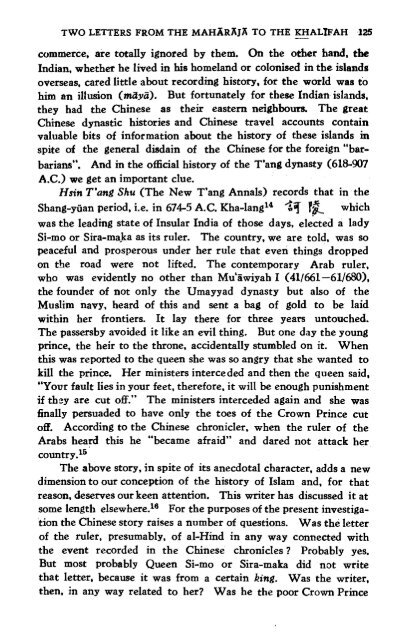TWO LETTERS FROM THE MAHARAJA TO THE KHALIFAH
TWO LETTERS FROM THE MAHARAJA TO THE KHALIFAH
TWO LETTERS FROM THE MAHARAJA TO THE KHALIFAH
You also want an ePaper? Increase the reach of your titles
YUMPU automatically turns print PDFs into web optimized ePapers that Google loves.
<strong>TWO</strong> <strong>LETTERS</strong> <strong>FROM</strong> <strong>THE</strong> <strong>MAHARAJA</strong> <strong>TO</strong> <strong>THE</strong> KHALTFAH - 125<br />
commerce, are totally ignored by them. On the other hand, the<br />
Indian, whether he lived in his homeland or colonised in the islands<br />
overseas, cared little about recording history, for the world was to<br />
him an illusion (mayii). But fortunately for these Indian islands,<br />
they had the Chinese as their eastern neighburs. The great<br />
Chinese dynastic histories and Chinese travel accounts contain<br />
valuable bits of information about the history of these islands in<br />
spite of the general disdain of the Chinese for the foreign "bar-<br />
barians". And in the official history of the T'ang dynasty (618-907<br />
A.C.) we get an important clue.<br />
Hsin T'ang Shu (The New T'ang Annals) records that in the<br />
Shang-yiian period, i.e. in 674-5 A.C. Kha-lang14 %f 7% which<br />
was the leading state of Insular India of those days, elected a lady<br />
Si-mo or Sira-maka as its ruler. The country, we are told. was so<br />
peaceful and prosperous under her rule that even things dropped<br />
on the road were not lifted. The contemporary Arab ruler.<br />
who was evidently no other than Mu'swiyah I (411661-61/680),<br />
the founder of not only the Umayyad dynasty but also of the<br />
Muslim navy. heard of this and sent a bag of gold to be laid<br />
within her frontiers. It lay there for three years untouched.<br />
The passersby avoided it like an evil thing. But one day the young<br />
prince, the heir to the throne. accidentally stumbled on it. When<br />
this was reported to the queen she was so angry that she wanted to<br />
kill the prince. Her ministers interceded and then the queen said,<br />
"Your fault lies in your feet, therefore. it will be enough punishment<br />
if thzy are cut off." The ministers interceded again and she was<br />
finally persuaded to have only the toes of the Crown Prince cut<br />
off. According to the Chinese chronicler. when the ruler of the<br />
Arabs heard this he "became afraid" and dared not attack her<br />
country.15<br />
The above story, in spite of its anecdotal character. adds a new<br />
dimension to our conception of the history of Islam and, for that<br />
reason, deserves our keen attention. This writer has discussed it at<br />
some length elsewhere.la For the purposes of the present investiga-<br />
tion the Chinese story raises a number of questions. Was the letter<br />
of the ruler. presumably, of al-Hind in any way connected with<br />
the event recorded in the Chinese chronicles? Probably yes.<br />
But most probably Queen Si-mo or Sira-maka did not write<br />
that letter, because it was from a certain king. Was the writer,<br />
then. in any way related to her? Was he the poor Crown Prince
















